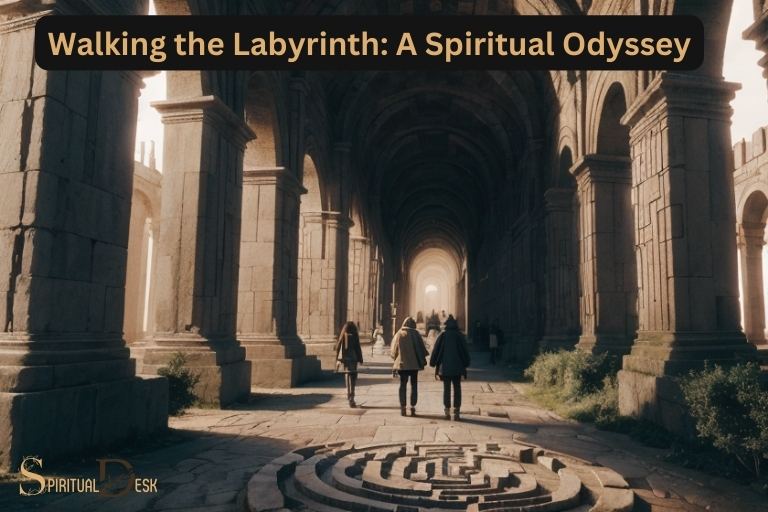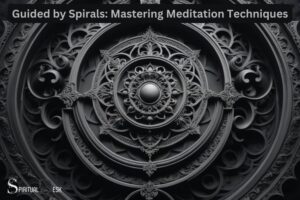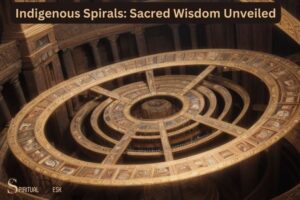Walking the Labyrinth: A Spiritual Odyssey
Walking the labyrinth is a spiritual odyssey that involves journeying along a single, circuitous path to the center and back out again. This practice started in ancient times and is used for meditation, prayer, personal introspection, or achieving inner peace.
Quick Overview
The odyssey of walking a labyrinth is a powerful spiritual tool that transcends religious beliefs. Its unique quality lies in its simplicity – there are no rules or wrong turns; only one path that leads you forward.
This meditative journey can provide profound insights into one’s life, foster self-reflection, and cultivate peace within oneself. It’s an internal voyage of discovery that reveals more about ourselves than our immediate surroundings.
Whether it’s used as part of a daily meditation routine or sought after during times of significant life changes, walking the labyrinth serves as an intimate mirror reflecting our innermost emotions, fears, hopes and dreams.

Preparing For Your Labyrinth Walk
Walking the spiral labyrinth can be a beautiful and transformative experience. The labyrinth, with its winding paths, invites us to embark on an inner journey of self-reflection and mindfulness.
However, before you step onto the labyrinth, it’s important to prepare yourself properly. This involves finding a labyrinth near you, choosing the right time for your walk, and dressing comfortably and practically. Let’s explore each of these aspects in more detail.
Finding A Labyrinth Near You
To start your labyrinth walk, locate a nearby accessible labyrinth. They’re commonly found in parks, churches, retreat centers, or private gardens. Use resources like the World-Wide Labyrinth Locator or ask local spiritual communities for guidance.
Choosing The Right Time For Your Walk
Choose your labyrinth walk time wisely to enhance your experience. Opt for quieter times like early mornings or late afternoons. Check the weather forecast to ensure comfort during your walk.
Dressing Comfortably And Practically
When it comes to dressing for your labyrinth walk, comfort and practicality should be your top priorities. Opt for loose-fitting and breathable clothing that allows for easy movement.
Since some labyrinths are located outdoors, it’s important to dress according to the weather conditions � layer up if it’s chilly, wear a hat and sunscreen if it’s sunny, and bring an umbrella if rain is expected. Wearing comfortable shoes is also crucial, as you’ll be on your feet for the duration of the walk.
Understanding The Spiral Labyrinth
Walking the spiral labyrinth is a powerful, transformative experience for inner connection, peace, and clarity. Its intricate spiral design symbolizes life’s journey and self-discovery. In this section, we explore labyrinth origins, spiral symbolism, and distinctions from mazes.
The Origins And History Of Labyrinths
The origins of labyrinths can be traced back thousands of years, with labyrinthine patterns found across different cultures and civilizations.
The most famous labyrinth, the labyrinth of Crete, was said to be built by Daedalus to imprison the Minotaur. Labyrinths were commonly used in ancient Greece and Rome as meditation tools or for ritual purposes.
Throughout history, labyrinths have held religious and spiritual significance. They were often incorporated into the design of cathedrals and churches, such as the Chartres Cathedral in France.
Walking the labyrinth became a spiritual practice for individuals seeking guidance, solace, and enlightenment.
Exploring The Symbolism Of The Spiral
The spiral, a common pattern found in labyrinths, holds deep symbolic meaning. It represents the cyclical nature of life, growth, and transformation.
Just like the spiral expands outward, our journey through the labyrinth mirrors our personal growth and evolution. Walking the spiral labyrinth becomes a metaphor for navigating the twists and turns of our own lives, embracing change, and making peace with the unknown.
The spiral can also symbolize the journey inward towards self-discovery and inner peace. As we walk the labyrinth’s winding path, we are encouraged to let go of distractions, quiet our minds, and listen to our inner voices.
The repetitive movement of walking the spiral allows us to enter a meditative state, facilitating self-reflection and bringing us closer to our own truths.
How Labyrinths Differ From Mazes
While labyrinths and mazes may appear similar, they have distinct differences. Mazes are designed as puzzles or challenges, with multiple paths and dead ends meant to confuse or disorient.
Labyrinths have a single, unobstructed path to the center, free from tricks or dead ends. They offer a continuous contemplative walk without the need to solve a puzzle. Labyrinths are meant for embrace and experience, not conquest or solving.
The Walk: Stepping Into The Labyrinth
Walk the labyrinth for self-discovery and reflection. Focus on the present moment. This section covers approach, intention, awareness, and distractions.
Setting An Intention For Your Walk
Set an intention before you start walking. Reflect on your purpose, whether it’s seeking clarity, inner peace, or openness
Once you have identified your intention, silently or mentally state it before you enter the labyrinth. Allow your intention to infuse every step you take, reminding yourself of its significance throughout the walk. By setting an intention, you create a purposeful and meaningful experience for yourself.
Walking With Awareness: Techniques And Tips
Walk the labyrinth with full presence, observing thoughts, feelings, and sensations without judgment.
Here are techniques to deepen your awareness:
- Breathe: Begin by taking a few deep breaths, allowing yourself to relax and be present. Focus on your breath as you continue walking.
- Slow down: Take your time with each step, savoring the sensation of your feet connecting with the ground. This slower pace encourages mindful awareness.
- Observe: Pay attention to the sensations in your body, the sounds around you, and the thoughts that arise. Notice any patterns or insights that emerge.
- Stay curious: Approach your walk with a sense of curiosity, allowing yourself to explore and discover new insights about yourself and your journey.
Embracing The Journey: Dealing With Distractions
During your walk, it’s natural for distractions to arise. Thoughts may wander, outside noises may interrupt your focus, or physical discomfort may arise. These distractions can pull you out of the present moment, but they also provide an opportunity for practice and growth.
Here are a few strategies to help you embrace distractions:
- Acceptance: Acknowledge that distractions are a normal part of the journey. Instead of resisting or becoming frustrated, accept them with a compassionate attitude.
- Refocus: When you notice your mind wandering, gently bring your attention back to your intention or your breath. Use this moment of refocusing to anchor yourself in the present.
- Let go: Release any attachments to thoughts or emotions that arise during the walk. Allow them to come and go, placing your focus on the experience of walking.
- Practice patience: Be patient with yourself as you navigate distractions. Remember that each step is an opportunity for growth and self-awareness.
Reflecting On Your Labyrinth Experience
Reflecting on your labyrinth experience is crucial for fully harnessing its power. As you walk the intricate paths, you may enter deep introspection, uncovering insights and connecting with your inner thoughts and emotions.
Here are three ways to engage in meaningful reflection: journaling your thoughts and emotions, sharing your experience with others, and integrating your insights into daily life.
Journaling Your Thoughts And Emotions
Journaling is a potent tool for self-reflection. Writing allows you to express thoughts, emotions, and observations from your labyrinth walk.
Begin with these prompts:
- Describe your initial expectations before entering the labyrinth.
- Reflect on any emotions that surfaced during the journey.
- Write about any significant insights or realizations you had.
- Explore how you felt physically while walking the labyrinth.
Allow your journaling practice to be free-flowing and non-judgmental. Write without censoring yourself, and embrace the process of self-discovery as you put pen to paper.
Connecting With Others: Sharing Your Experience
Connecting with others by sharing your labyrinth experience can deepen your understanding and build community. Explaining your journey to someone who hasn’t walked the labyrinth can be illuminating.
Share these aspects of your experience:
- The emotions you encountered and how they have affected your perspective.
- The insights gained and how they relate to your personal growth.
- The physical sensations experienced, such as the rhythm of your steps or the feeling of the labyrinth’s energy.
Sharing your experience not only helps you solidify your own reflections but also offers others the opportunity to learn from your journey. It can be a catalyst for inspiring conversations and deep connections.
Integrating Insights And Epiphanies Into Daily Life
The labyrinth experience is not limited to the time spent walking its paths. It carries a lasting impact that can be integrated into your daily life. Take the lessons learned and the insights gained and find ways to weave them into your routines, mindset, and behavior.
- Set aside moments of stillness and reflection each day, allowing yourself to tap into the inner wisdom accessed during your labyrinth walk.
- Practice mindfulness and presence, cultivating a deeper connection to the present moment and the sensations around you.
- Seek opportunities for personal growth and exploration, embracing the adventurous spirit you discovered within the labyrinth.
- Share the teachings of the labyrinth with others, spreading the transformative power of this ancient practice.
By integrating your labyrinth insights into your daily life, you can make profound and lasting changes that promote inner peace, self-awareness, and spiritual growth.
Exploring Further: Resources And Retreats
Exploring further: Resources and retreats can deepen your labyrinth journey. Walking the spiral labyrinth is a transformative, meditative practice that fosters clarity, peace, and spiritual connection. In this section, we’ll delve into valuable resources and opportunities for labyrinth enthusiasts.
Books And Websites On Labyrinth Walking
If you want to delve deeper into the rich history and symbolism of labyrinth walking, there are several noteworthy books and websites available. These resources can provide scholarly insights, personal experiences, and practical guidance to help you navigate through the labyrinthine path. Here are a few recommended books and websites:
Books on Labyrinth Walking:
- “Walking a Sacred Path” by Lauren Artress: This influential book, written by a pioneer in the modern labyrinth movement, explores the spiritual and transformative aspects of labyrinth walking. Artress offers profound insights and practical guidance for incorporating labyrinth practices into daily life.
- “The Sacred Path Companion” by Lauren Artress: This companion book serves as a valuable resource for those embarking on a labyrinth journey. It provides journaling exercises, prayers, and reflections to deepen your connection with the labyrinth and yourself.
- “The Labyrinth Society” (Website): The Labyrinth Society is an international organization dedicated to promoting labyrinth awareness and education. Their website offers a wealth of information, including research articles, labyrinth locator tools, and a community forum for labyrinth enthusiasts to connect and share experiences.
Labyrinth Retreat Centers And Workshops
If you are seeking a more immersive labyrinth experience, consider attending a labyrinth retreat or workshop. These centers provide dedicated spaces for reflection, guidance from experienced facilitators, and opportunities to connect with like-minded individuals on a labyrinth pilgrimage. Here are a few renowned labyrinth retreat centers and organizations:
Incorporating Labyrinth Practices Into Daily Routine
To integrate labyrinth practices into your daily routine and stay grounded, consider these simple approaches:
- Walking Mindfully: Take a few moments each day to walk mindfully, bringing the labyrinth experience to any outdoor path or indoor space.
- Meditating with Labyrinth Imagery: Close your eyes and visualize yourself walking the labyrinth, using the imagery to guide your meditation and find inner peace.
- Journaling: Keep a labyrinth journal to record your thoughts, reflections, and insights before or after each labyrinth journey. This can help deepen your understanding and track your progress over time.
Whether you dive into labyrinth-related literature, attend a retreat, or weave labyrinth practices into your daily routine, these resources and opportunities can enhance your labyrinth journey, providing guidance, inspiration, and a supportive community. The labyrinth holds mysteries waiting to be discovered, and with these resources at hand, your exploration will undoubtedly be enriched.
The Benefits Of Walking The Spiral Labyrinth
Walking the spiral labyrinth is a meditative practice that has been used for centuries as a tool for self-reflection and spiritual growth. This ancient pathway, with its winding path and symbolic patterns, offers a unique journey for those who seek inner peace and clarity. But the benefits of walking the spiral labyrinth extend far beyond just spiritual enlightenment. In this post, we will explore three key benefits of this practice and how they can positively impact your well-being.
Reducing Stress And Anxiety
Walking the spiral labyrinth significantly reduces stress and anxiety. In our fast-paced world, constant stimuli can overwhelm us.
The labyrinth provides a sacred space to step away from chaos and find solace in the rhythmic footsteps. Walking it with intentional focus calms the mind and releases tension.
Studies show that walking meditations like the spiral labyrinth activate the parasympathetic response, promoting a state of relaxation, reducing stress hormones, lowering blood pressure, and enhancing overall well-being.
Enhancing Mindfulness And Focus
As you walk, you become keenly aware of your bodily sensations, breath, and surroundings.
The labyrinth’s design serves as a visual focal point, anchoring your attention. This reduces mental clutter, leading to improved mental clarity and focus. This heightened mindfulness can extend to your daily life, helping you stay present and focused.
Cultivating Creativity And Intuition
Walking the spiral labyrinth can also unlock the doors to your innate creativity and intuition. The fluid movements and symbolism of the labyrinth engage both the logical and intuitive parts of the brain, bridging the gap between analytical thinking and creative inspiration.
By stepping onto the labyrinth, you enter a realm where rationality and linear thought take a backseat, making way for intuitive insights and imaginative ideas to flow freely.
This creative surge can help you find novel solutions to problems, stimulate artistic endeavors, and tap into your innermost desires.
The circular labyrinth path fosters a feeling of safety, encouraging you to release inhibitions and trust your instincts. This practice can catalyze self-discovery, unlocking your creative potential and unleashing endless possibilities.
Variations And Adaptations Of The Spiral Labyrinth
The spiral labyrinth has been an intriguing symbol of spiritual and personal transformation throughout history. Its ancient origins can be traced back to various cultures around the world, each adding their own unique variations and adaptations to this mesmerizing design.
In this section, we explore some modern interpretations of the spiral labyrinth that have found their place in architecture, virtual spaces, and even inside the comfort of our own homes.
Modern Interpretations: Labyrinths In Architecture
One fascinating way the spiral labyrinth has made its mark in modern times is through its incorporation into architectural structures. Bold architects and designers have embraced this ancient symbol, infusing it into the very fabric of buildings.
Bold, geometric patterns inspired by the spiral labyrinth adorn walls, floors, and even facades. These architectural labyrinths serve as a visual representation of journeys, inviting visitors to embark on a symbolic exploration of self-discovery and reflection.
Virtual Labyrinths And Guided Labyrinth Walks
In the digital age, the spiral labyrinth has found its way into the virtual realm. Virtual labyrinths and guided labyrinth walks offer an immersive experience for those who seek solace and introspection.
Guided labyrinth walks, accompanied by soothing audio and visual cues, provide a virtual guide through the labyrinth, enhancing the meditative experience.
Creating A Personal Labyrinth At Home
Creating a personal labyrinth at home offers a fulfilling and therapeutic experience. It can be made indoors or outdoors using materials like stones, wood, or paint. Walking the labyrinth provides moments for reflection and intention, promoting calm and clarity.
Crafting your labyrinth lets you express creativity and connect with its rich history, adding a personal touch to this sacred symbol, whether it’s permanent or temporary.
Conclusion
The Spiral Labyrinth offers a sacred and meditative experience, allowing visitors to connect with their inner selves and the world around them.
By walking the intricate paths, we embark on a journey of self-discovery and introspection. The labyrinth’s design serves as a metaphor for life’s twists and turns, teaching us patience and resilience.
So, embrace the opportunity to explore this mesmerizing labyrinth, and let it guide you towards peace and mindfulness in your everyday life.






